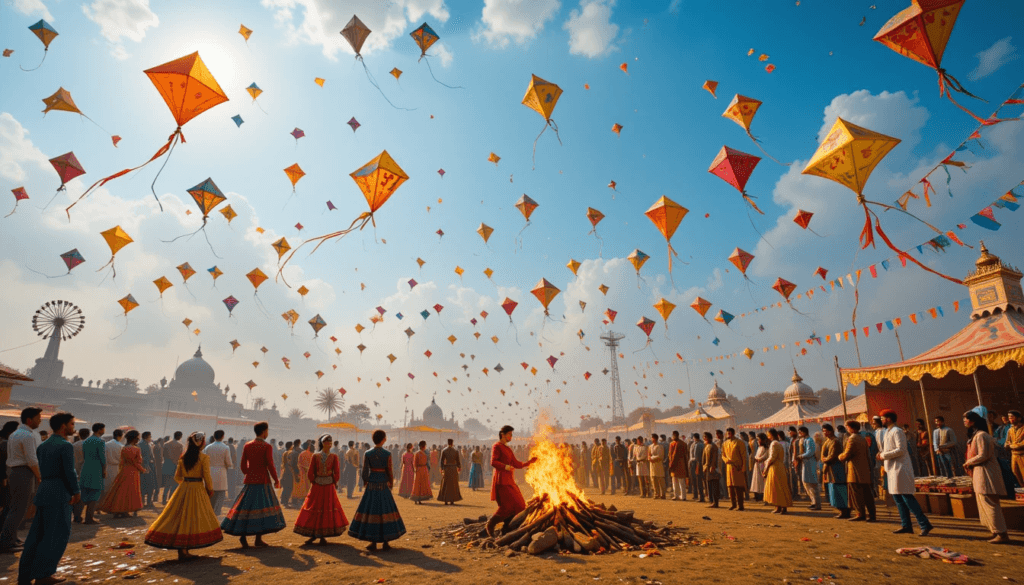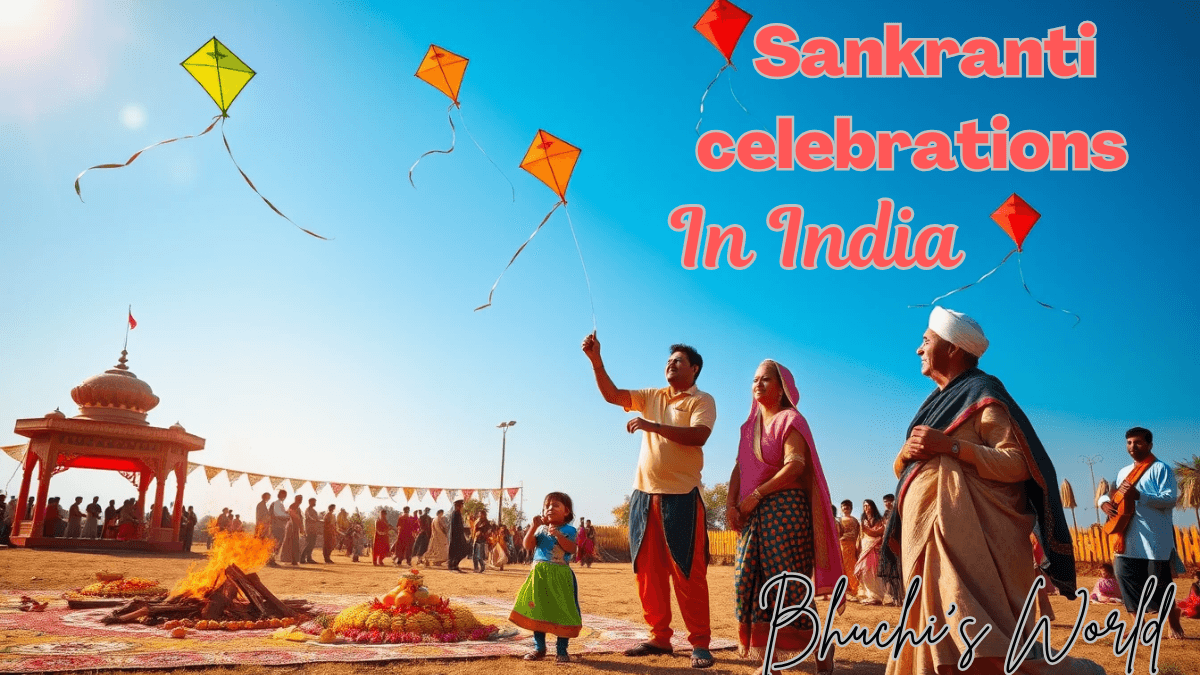Sankranthi is an important festival in India that celebrates agriculture and spirituality. It takes place in January and marks the Sun’s move into Capricorn, known as Makara Sankranti. This change signifies longer days and warmer weather, representing hope, abundance, and renewal.
Sankranti Celebrations in India a harvest festival that expresses gratitude to the Sun God (Surya) for a successful harvest. Celebrated with diverse traditions across India, it symbolizes unity and cultural richness. In Gujarat, colorful kites fill the skies, while Tamil Nadu homes glow with intricate rangoli designs. Andhra Pradesh lights up with joyful bonfires, marking renewal and positivity. The festival’s essence lies in bringing people together through rituals, feasts, and joyous activities, honoring nature’s bounty. Sankranti is more than a celebration—it is a tribute to agrarian roots and a reminder of harmony, gratitude, and the shared joy of communities.
Historical and Cultural Significance of Sankranthi

Sankranthi’s origins are deeply rooted in India’s agrarian past and spiritual traditions. It is celebrated to acknowledge the farmers’ hard work and to thank nature for the harvest. Historically, the festival coincided with the winter solstice, marking the Sun’s northward journey (Uttarayana). This transition is deemed highly auspicious in Hindu scriptures and is associated with spiritual growth and prosperity.
The festival also carries a mythological significance. One popular tale involves the demon king Sankarasura, whose defeat by Lord Vishnu is celebrated as Sankranthi. Another legend connects the festival to the Sun God and his reunion with his son, Shani, symbolizing familial bonds.
Traditional Rituals and Customs of Sankranthi
The vibrancy of Sankranthi celebrations is reflected in its diverse rituals and customs. Each day of the festival—Bhogi, Sankranthi, and Kanuma—is celebrated with unique traditions:
Bhogi Bonfires
Sankranti Celebrations in India begin with Bhogi, a day dedicated to discarding old and unwanted items by lighting bonfires. This act symbolizes letting go of negativity and welcoming new beginnings. Families gather around these fires, singing traditional songs and sharing stories.
Worship of Cattle
Cattle, an integral part of agricultural life, are worshipped during Kanuma. Farmers decorate their livestock with vibrant colors, garlands, and bells, acknowledging their contribution to the harvest. In some regions, cattle races and games add a competitive yet festive touch.
Kite Flying and Rangoli Making
In states like Gujarat and Rajasthan, kite flying is a beloved activity during Sankranthi. Skies are dotted with colorful kites, as people compete to cut each other’s strings. Women adorn their homes with intricate rangoli patterns, believed to invite prosperity and happiness.
Charity and Sharing
The spirit of makara Sankranthi emphasizes sharing with the less fortunate. People distribute sweets, grains, and other essentials to the needy, fostering a sense of community and kindness.
Culinary Delights of Sankranthi
Sankranthi celebrations in India are incomplete without indulging in traditional festive foods. The dishes prepared during this festival reflect the region’s agricultural produce and culinary heritage.
Sweet Pongal
In Tamil Nadu, sweet pongal, made with freshly harvested rice, jaggery, and ghee, takes center stage. Cooked in earthen pots, this dish is offered to the Sun God before being shared among family and friends.
Tilgul and Sesame Delights
In Maharashtra, sesame (til) and jaggery-based sweets like tilgul laddoos and gulachi poli are prepared. These delicacies are exchanged with the phrase, “Tilgul ghya, god god bola,” encouraging sweetness in relationships.
Savory Festive Meals
Andhra Pradesh and Telangana celebrate with an elaborate spread, including pulihora (tamarind rice), boorelu (fried sweet dumplings), and arisa (traditional rice flour cookies). These dishes highlight the importance of local flavors and seasonal ingredients.
Cultural Variations in Food
Each state adds its unique culinary twist to the festival, showcasing India’s rich gastronomic diversity. From the kite-shaped sweets of Gujarat to Punjab’s makki di roti and sarson da saag, Sankranthi’s food offerings are as diverse as its celebrations.
Also Read : Top 5 Temples in India You Must Visit
Sankranti Celebrations in India Across The States

Sankranthi’s beauty lies in its regional variations, where each state adds its cultural identity to the festival:
Tamil Nadu (Pongal)
In Tamil Nadu, Sankranti is celebrated as Pongal, a vibrant four-day festival dedicated to expressing gratitude for nature’s harvest. Homes are adorned with colorful kolams (rangoli), symbolizing prosperity and joy. Families prepare traditional pongal dishes, a sweet rice delicacy, as offerings to thank the Sun God and nature. The festival also includes unique cultural elements like cattle races, showcasing the region’s agrarian roots, and traditional folk dances such as karagattam, adding rhythm and color to the celebrations. Pongal embodies the spirit of community, gratitude, and joy, blending tradition with festivity to honor the harvest and Tamil Nadu’s rich heritage.
Andhra Pradesh and Telangana
Sankranti is a grand celebration in Telugu states, characterized by vibrant Bhogi bonfires, cultural performances, and communal feasts that bring communities together. The festival highlights rural traditions through Kanuma, a day dedicated to honoring cattle, symbolizing agrarian gratitude. Pedda Panduga, meaning “Big Festival,” emphasizes family gatherings, fostering love and togetherness.
Gujarat (Uttarayan)
Gujarat comes alive with vibrant colors during Sankranthi, especially in Ahmedabad, where the International Kite Festival takes center stage. Participants from across the globe gather to showcase their kite-flying skills in exciting competitions. The skies are filled with an array of colorful kites, creating a breathtaking spectacle. The festival is not just about kites but also a celebration of Gujarat’s rich cultural heritage. Folk music, traditional dances, and lively performances add to the festive spirit, creating a joyful and energetic atmosphere. This unique blend of tradition and fun makes Sankranthi in Gujarat an unforgettable experience.
Punjab (Lohri)
In Punjab, Lohri is celebrated as a vibrant winter harvest festival, marking the end of winter and the arrival of a new agricultural season. Bonfires are lit in communities, symbolizing the warmth and light that drive away the cold. People gather around the fire to celebrate with traditional bhangra and gidda dances, filling the air with joy and energy. The festival is a time for families and friends to come together, offering prayers for a prosperous harvest. Lohri’s lively dances, music, and festive spirit make it a cherished celebration of both nature’s cycles and cultural traditions.
Karnataka and Maharashtra
In Karnataka, Sankranthi is celebrated with grand feasts, folk performances, and a unique tradition of cattle worship. Farmers honor their livestock, acknowledging their role in the agricultural cycle. The festivities are marked by vibrant cultural expressions, including music, dance, and colorful rituals, celebrating the harvest season. In Maharashtra, the festival fosters a sense of unity and goodwill. People exchange tilgul laddoos and other sweets as a gesture of peace and friendship, saying “Tilgul ghya, god bola” (Take tilgul, speak sweet). These customs strengthen community bonds and spread joy during the harvest festival.
Sankranthi in Modern Times: Preserving Traditions with a Twist
With urbanization and changing lifestyles, Sankranthi celebrations have adapted to modern times while preserving traditional values. Eco-friendly practices, such as using organic rangoli powders and biodegradable kites, have gained popularity. Social media and online platforms have also brought global attention to this festival, encouraging younger generations to reconnect with their roots.
In urban areas, people celebrate with cultural events, kite-flying competitions, and community feasts. However, efforts are being made to ensure these modern adaptations do not overshadow the festival’s core essence—gratitude towards nature and unity among people.
Sankranthi: A Celebration of Unity and Gratitude
Sankranti celebrations in India are more than just a festival; it is a celebration of life, gratitude, and the harmonious relationship between humanity and nature. Through its diverse rituals, regional flavors, and unifying message, Sankranthi teaches us the importance of sustainability, kindness, and cultural pride.
Whether it’s the rhythmic beats of dhol during Lohri, the artistic charm of rangoli, or the competitive spirit of kite-flying, Sankranthi captures the vibrant spirit of India. As families gather to celebrate, this festival continues to strengthen bonds, preserve traditions, and spread joy across generations.
FAQs About Sankranti Celebrations in India
What does Sankranthi signify in Indian culture?
Sankranthi symbolizes the Sun’s transition into Capricorn, marking the end of winter and the start of a new harvest season.
Why is kite flying associated with Sankranthi?
Kite flying is a tradition in states like Gujarat and Rajasthan, representing joy and competition during the festival.
How is Pongal different from Sankranthi?
Pongal, celebrated in Tamil Nadu, is a four-day festival dedicated to the harvest, while Sankranthi encompasses broader regional variations.
What foods are prepared during Sankranthi?
Festive foods include sweet pongal, tilgul laddoos, pulihora, and sarson da saag, reflecting regional culinary diversity.
How has Sankranthi evolved in modern times?
Modern celebrations incorporate eco-friendly practices, cultural events, and digital engagement while retaining traditional values.
Why is Sankranthi important for farmers?
The festival honors the agricultural cycle, offering gratitude for the harvest and seeking blessings for future prosperity.
How is Sankranti celebrated in South India?
In South India, Sankranti is celebrated as Pongal, a four-day festival that includes cooking a special dish, flying kites, and giving thanks for the harvest. People decorate their homes with kolams (rangoli designs) and offer prayers for prosperity.
Discover more from Bhuchi's World
Subscribe to get the latest posts sent to your email.

